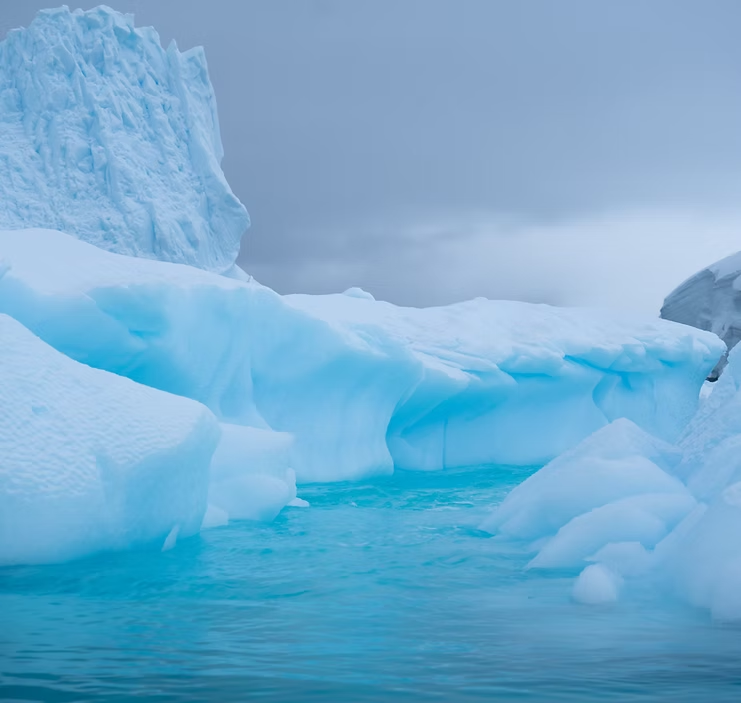
Ross Ice Shelf
Explore Ross Ice Shelf
Ross Ice Shelf
Ross Ice Shelf: The Largest Ice Shelf in Antarctica
The Ross Ice Shelf is the largest floating ice shelf on Earth, covering an area roughly the size of France. This massive sheet of ice, which extends from the Antarctic mainland into the Ross Sea, is a crucial part of the continent’s glacial system. Known for its towering ice cliffs, deep crevasses, and surreal blue landscapes, the Ross Ice Shelf is one of the most awe-inspiring sights in Antarctica. Visitors on specialized Antarctic expeditions may have the rare opportunity to witness this frozen frontier up close.
Frequently Asked Questions: Ross Ice Shelf
The Ross Ice Shelf is only accessible during the Antarctic summer (November to March) when conditions allow travel:
- November to December: Pristine ice formations, glacial calving events, and long daylight hours.
- January to February: Warmer temperatures, best for ice exploration and wildlife spotting.
- March: Late-season sunsets and excellent whale-watching opportunities in the Ross Sea.
- Towering Ice Cliffs – The Ross Ice Shelf’s edge features glacial walls over 50 meters (165 feet) high.
- McMurdo Sound – A region where the ice shelf meets the open sea, offering breathtaking ice formations.
- Ross Island & Mount Erebus – A volcanic island near the ice shelf, home to the southernmost active volcano on Earth.
- Research Stations – The shelf plays a crucial role in climate studies, with nearby McMurdo Station (U.S.) and Scott Base (New Zealand) conducting ongoing research.
- Wildlife Encounters – While the ice shelf itself is mostly barren, Emperor Penguins, Weddell Seals, and Minke Whales can be spotted along its edges.
- Historic Exploration Sites – The ice shelf was a launch point for famous Antarctic expeditions, including those of Ernest Shackleton and Robert Falcon Scott.
The Ross Ice Shelf is uninhabited, and all meals are provided onboard expedition cruises or at research stations:
- Hearty soups and stews – A staple for staying warm in Antarctica.
- Freshly baked bread & desserts – A highlight at research stations like McMurdo.
- Hot drinks – Coffee, tea, hot chocolate, and mulled wine are popular onboard expedition ships.
- International cuisine – Luxury Antarctic cruises offer gourmet dining with ingredients flown in from South America.
- Expedition Cruises: The most common way to visit, with ships departing from New Zealand or South America.
- Icebreaker Ships: Required to reach the Ross Ice Shelf in heavily frozen waters.
- Zodiac Boats: Used for excursions to the ice edge, where visitors can see glacial formations and wildlife.
- Helicopter Tours: Some research teams and exclusive expeditions offer aerial views of the ice shelf.
- Antarctica has no official currency—most transactions occur onboard cruise ships.
- McMurdo Station Store accepts U.S. Dollars (USD) for small purchases.
- No ATMs or banks exist in Antarctica—bring any necessary cash before departure.
- English is the primary language spoken at research stations and on Antarctic cruises.
- Some scientific teams speak Spanish, French, or Russian, depending on their home country.
- No native human population exists in Antarctica.
- Follow strict environmental rules—no littering, no touching wildlife, and leave nothing behind.
- Keep a safe distance from wildlife—at least 5 meters (15 feet) from penguins and seals.
- Minimize human impact—stick to designated paths and follow expedition leader instructions.
- Photography is allowed, but avoid using flash near wildlife.
- Respect research stations—if visiting, follow all guidelines and instructions from scientists.
- Tipping is common on Antarctic cruises but not required.
- Guides & Expedition Crew: $10–$20 per person per day.
- Housekeeping & Ship Staff: $5–$10 per person per day.
- Tipping can usually be done at the end of the cruise in cash or via onboard accounts.
- For peak season (December–February): Book 12–18 months in advance for the best cabins and pricing.
- For last-minute deals: Some operators offer discounts, but options are limited.
- For fly-cruise options: Book at least 12 months in advance, as these trips are rare.
- COVID-19 restrictions have been lifted, but always check with your tour operator for health protocols.
- Strict environmental regulations apply—visitors must adhere to the Antarctic Treaty and IAATO guidelines.
- Extreme weather may impact itineraries—flexibility is key when traveling to Antarctica.
- No medical facilities on the ice shelf—serious medical issues require evacuation.
Contact us at 281-229-0862 or admin@pointmetoparadise.com
